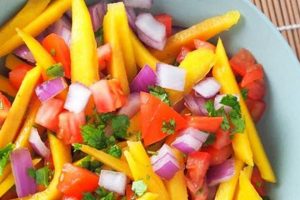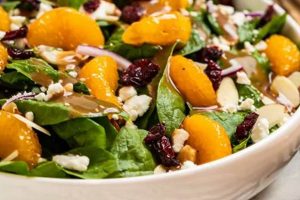A simple preparation of this dish typically involves cooked turkey, mayonnaise, and seasonings. Celery, onion, grapes, or nuts are common additions. Variations exist, substituting Greek yogurt for mayonnaise or incorporating diverse spices and herbs for unique flavor profiles. An example might include diced turkey breast, mayonnaise, chopped celery, red onion, salt, pepper, and a touch of Dijon mustard.
Quick and customizable, this dish offers a practical way to utilize leftover cooked turkey. Its adaptability allows for diverse ingredients to match individual preferences and dietary needs. Historically, similar salad preparations predate refrigeration, showcasing resourcefulness in using cooked meats. The modern iteration emerged alongside the rise of readily available mayonnaise in the early 20th century. Its convenience contributed to its popularity as a luncheon staple and quick meal.
This exploration of streamlined versions of this classic dish will delve into ingredient selection, variations for diverse dietary needs, and techniques for optimizing flavor and texture. Considerations for presentation and storage will also be addressed.
Tips for Simple Turkey Salad Preparation
Optimizing flavor and texture in a simple turkey salad involves attention to ingredient quality and preparation techniques. The following tips offer guidance for a successful outcome.
Tip 1: Moisture Control is Key Excess moisture can dilute flavor and create a less appealing texture. Thoroughly pat dry cooked turkey before dicing. Similarly, drain any excess liquid from canned or jarred ingredients like diced water chestnuts.
Tip 2: Texture Enhancement Consider textural variety. Crisp elements, such as celery, water chestnuts, or chopped apples, provide a welcome counterpoint to the soft turkey and creamy base.
Tip 3: Fresh Herbs Elevate Flavor Fresh herbs contribute a brightness that dried herbs often lack. Finely chopped parsley, dill, chives, or tarragon can significantly enhance the overall flavor profile.
Tip 4: Balanced Seasoning Avoid over-salting. Start with a modest amount of salt and pepper and adjust to taste after the salad has rested for a short period, allowing flavors to meld.
Tip 5: Mayonnaise Alternatives For a lighter version, substitute plain Greek yogurt or a mixture of yogurt and mayonnaise. This also adds a tangy note.
Tip 6: Proper Chilling Allow the salad to chill for at least 30 minutes before serving. This allows the flavors to meld and the salad to firm up slightly, improving its texture.
Tip 7: Strategic Ingredient Incorporation Add delicate ingredients like grapes or dried cranberries towards the end of preparation to prevent crushing or excessive softening.
By following these tips, one can ensure a flavorful, well-balanced, and satisfying turkey salad experience.
These practical tips provide a foundation for crafting a consistently delicious and adaptable turkey salad. Further exploration of specific recipes and variations can build upon these fundamental principles.
1. Simple Ingredients
The ease of a turkey salad recipe often directly correlates with the simplicity of its ingredients. Recipes emphasizing readily available components minimize preparation time and complexity. For example, using pre-cooked turkey breast eliminates the need for roasting a whole bird or individual portions. Similarly, opting for common pantry staples like mayonnaise, celery, and onion reduces ingredient sourcing efforts. This focus on accessible ingredients contributes significantly to the “easy” aspect of the recipe, making it achievable for a broader range of cooks, regardless of skill level or time constraints.
Furthermore, the use of simple ingredients allows for greater flexibility in customization. While a basic recipe might call for turkey, mayonnaise, and celery, the cook can easily adapt it based on personal preferences or dietary needs. Swapping mayonnaise for Greek yogurt creates a lighter version. Adding grapes introduces sweetness, while incorporating chopped nuts provides textural contrast. This adaptability makes the simple turkey salad recipe a versatile foundation for culinary exploration, even with a limited pantry.
Ultimately, the emphasis on simple ingredients democratizes the turkey salad, transforming it from a potentially complex dish into an accessible and adaptable meal. This accessibility encourages culinary experimentation and ensures that enjoying a flavorful and satisfying turkey salad remains within reach for a wide audience. This principle of simplicity extends beyond individual recipes, reflecting a broader trend in convenient and adaptable meal preparation. The practical application of this understanding simplifies meal planning and execution, promoting efficient use of time and resources.
2. Quick Preparation
Quick preparation is a defining characteristic of an easy turkey salad recipe. The speed at which this dish can be assembled contributes significantly to its appeal, particularly for those seeking convenient meal options. This rapid preparation stems from several factors, including the use of pre-cooked ingredients and minimal cooking requirements. Since the turkey is already cooked, the process primarily involves combining ingredientschopping vegetables, mixing with mayonnaise or a chosen alternative, and seasoning. This streamlined process allows for a complete meal preparation in a short timeframe, often under 15 minutes. For example, a simple recipe might require only dicing cooked turkey, celery, and onion, then combining these ingredients with mayonnaise, salt, and pepper. Such recipes offer a practical solution for busy weeknight meals or quick lunches.
The practical significance of this quick preparation extends beyond mere convenience. It allows for greater flexibility in meal planning. A quick turkey salad can be assembled shortly before serving, eliminating the need for extensive advance preparation. This adaptability makes it suitable for impromptu gatherings or situations where time is limited. Furthermore, the speed of preparation minimizes cleanup, contributing to the overall ease and efficiency of the meal. Consider a scenario where a quick and nutritious lunch is required. A readily available container of pre-cooked turkey can be transformed into a satisfying salad within minutes, minimizing both active preparation time and subsequent dishwashing.
The connection between quick preparation and an easy turkey salad recipe is undeniable. This speed and simplicity make the dish an attractive option for individuals seeking convenient, healthy, and flavorful meals. Understanding the factors contributing to this ease of preparation empowers individuals to efficiently utilize their time and resources in the kitchen. This efficiency, in turn, promotes more frequent home-cooked meals, even within the constraints of busy schedules, leading to potentially healthier dietary choices and greater control over ingredients.
3. Minimal Cooking
Minimal cooking stands as a cornerstone of the “easy” designation for turkey salad recipes. The reduced reliance on heat simplifies the preparation process, shortening overall cooking time and minimizing cleanup. This efficiency makes the dish accessible to a wider range of individuals, irrespective of their culinary expertise or available time. The primary cooking effort typically involves preparing the turkey itself, which can be achieved through various methods such as roasting, grilling, or even using pre-cooked store-bought options. Once the turkey is cooked, the remaining steps primarily involve combining ingredients at room temperature, further emphasizing the minimal cooking aspect. For instance, a recipe might call for combining diced cooked turkey with mayonnaise, chopped celery, onion, and seasonings a process requiring no further application of heat. This characteristic differentiates turkey salad from more complex salad preparations that might involve cooking grains, beans, or other components.
The practical significance of this minimal cooking requirement extends beyond mere convenience. It offers flexibility in meal preparation, allowing for quick assembly even in settings with limited cooking facilities. Consider a workplace lunch scenario: a simple turkey salad can be easily assembled at one’s desk with readily available ingredients, eliminating the need for access to a kitchen or cooking appliances. This adaptability makes turkey salad a viable option for picnics, potlucks, or other situations where traditional cooking methods might be impractical. Furthermore, the reduced cooking time contributes to energy efficiency, aligning with broader trends towards sustainable kitchen practices. Using pre-cooked turkey or leftover turkey from a previous meal further reduces the overall environmental impact.
In summary, the minimal cooking requirement intrinsic to easy turkey salad recipes contributes significantly to their accessibility and convenience. This characteristic broadens the appeal of the dish, making it a viable option for a wide range of individuals and situations. Understanding the connection between minimal cooking and the “easy” label allows for greater appreciation of the dish’s practicality and efficiency. It also highlights the potential for further adaptations and variations, all while maintaining the core principle of simplicity in preparation. This simplicity empowers individuals to integrate home-cooked, nutritious meals into their routines, even amidst the demands of a fast-paced lifestyle.
4. Customizable Flavors
The inherent adaptability of turkey salad recipes contributes significantly to their categorization as “easy.” Customizable flavors empower individuals to tailor the dish to precise preferences and dietary needs, utilizing readily available ingredients. This flexibility stems from the salad’s simple basecooked turkey combined with a binding agent, typically mayonnaise. This foundational structure provides a blank canvas for flavor exploration. The integration of various ingredientsherbs, spices, fruits, nuts, and vegetablesallows each preparation to reflect individual tastes. For example, a preference for savory profiles might lead to the inclusion of Dijon mustard, chopped pickles, and fresh dill. Conversely, a desire for sweetness could introduce dried cranberries, chopped apples, and a touch of honey.
This customizability extends beyond personal preferences to address dietary restrictions and health-conscious choices. Substituting plain Greek yogurt for mayonnaise creates a lower-fat, higher-protein version. Individuals avoiding gluten can ensure the salad remains gluten-free by carefully selecting gluten-free bread or crackers for serving. The adaptability of the base recipe also simplifies portion control and ingredient modification to align with specific caloric or macronutrient targets. For instance, incorporating more vegetables, such as chopped bell peppers or cucumbers, increases fiber content and overall nutritional value while managing caloric density. This adaptability promotes balanced meal planning without sacrificing flavor or satisfaction.
In summary, customizable flavors represent a key aspect of what makes a turkey salad recipe “easy.” This inherent flexibility allows for adaptation to individual preferences, dietary needs, and available ingredients. This customizability reduces reliance on rigid recipes, promoting culinary creativity and ensuring a satisfying outcome regardless of specific ingredient choices. Ultimately, this characteristic fosters consistent meal enjoyment, making regular preparation more sustainable and contributing to a healthier, more personalized approach to diet.
5. Versatile Serving Options
Versatile serving options represent a significant factor contributing to the “easy” designation of turkey salad recipes. This versatility stems from the salad’s adaptable nature, lending itself to various presentations and accompaniments. This characteristic simplifies meal planning and reduces reliance on strict recipe adherence. The salad functions effectively as a standalone dish, a sandwich filling, a component within lettuce wraps, or a topping for crackers or crostini. This adaptability allows for varied presentations based on available ingredients, time constraints, and desired meal structure. For instance, a quick lunch might involve serving the turkey salad on crackers or within a croissant. A more elaborate meal might feature the salad atop a bed of mixed greens with a vinaigrette dressing. This flexibility ensures the dish remains convenient and appealing across diverse contexts.
The practical implications of versatile serving options extend beyond convenience. This adaptability simplifies the integration of turkey salad into diverse dietary patterns and preferences. Individuals seeking low-carbohydrate options might opt for lettuce wraps or serve the salad with crudits. Those prioritizing whole grains might choose whole-wheat bread or crackers. This adaptability accommodates dietary restrictions and preferences without requiring significant recipe modifications. Consider a social gathering with diverse dietary needs: turkey salad offers a solution that can be adapted to meet individual requirements without necessitating separate dishes. This versatility simplifies meal preparation for hosts and ensures all attendees have palatable and accessible options. Furthermore, the adaptability of serving options minimizes food waste. Leftover turkey salad can be repurposed creatively, reducing the likelihood of discarding unused portions.
In summary, versatile serving options contribute significantly to the ease and practicality of turkey salad recipes. This characteristic allows for simple adaptation to various meal formats and dietary preferences, enhancing the dish’s overall convenience. This adaptability simplifies meal planning, reduces reliance on rigid recipes, and promotes efficient utilization of ingredients. Understanding the link between versatile serving options and the “easy” designation reinforces the practical value of this dish, promoting its integration into a wide range of meal plans and culinary contexts.
6. Leftover Utilization
Leftover utilization plays a crucial role in the appeal of easy turkey salad recipes. This resourcefulness directly contributes to the “easy” designation by providing a convenient and practical application for cooked turkey, often remaining after holiday meals or large-batch cooking. This repurposing minimizes food waste and simplifies subsequent meal preparation. The existing cooked turkey eliminates a significant step in the salad-making process, further enhancing the recipe’s ease. Instead of requiring dedicated time for cooking poultry, one can seamlessly incorporate pre-cooked turkey, accelerating overall preparation. For example, leftover Thanksgiving turkey readily transforms into a flavorful salad the following day, requiring minimal additional effort. This practical application extends beyond holiday leftovers; a roasted turkey breast prepared for Sunday dinner can efficiently become a quick and easy weeknight lunch in salad form.
This resourcefulness translates into tangible benefits beyond mere convenience. Utilizing leftovers contributes to household cost savings by maximizing the value of purchased ingredients. It reduces reliance on pre-packaged meals or takeout, potentially leading to healthier dietary choices. Moreover, minimizing food waste aligns with broader sustainability efforts, reducing environmental impact. Consider a scenario where a significant amount of cooked turkey remains after a family gathering. Transforming this surplus into turkey salad provides multiple meals, preventing spoilage and reducing the need for additional grocery shopping. This practice promotes responsible consumption and minimizes the environmental footprint associated with food production and disposal. Furthermore, leftover utilization encourages culinary creativity, offering an opportunity to experiment with flavor combinations and personalize the salad based on available ingredients.
In conclusion, leftover utilization constitutes a cornerstone of the “easy” turkey salad recipe concept. This resourcefulness simplifies meal preparation, minimizes food waste, and promotes cost savings. Understanding the connection between leftover utilization and the ease of these recipes fosters a more sustainable and economical approach to cooking. This understanding encourages mindful consumption and enhances the practical value of turkey as a versatile ingredient, extending its culinary applications beyond initial meal preparations. This resourcefulness ultimately empowers individuals to create delicious and efficient meals while minimizing environmental impact and maximizing the value of available ingredients.
Frequently Asked Questions
This section addresses common inquiries regarding easy turkey salad recipes, offering practical guidance for optimal preparation and enjoyment.
Question 1: What is the best way to prevent a watery turkey salad?
Excess moisture can result from insufficiently drained ingredients or over-processing the turkey. Thoroughly patting the turkey dry before dicing and using crisp vegetables minimizes water content. Adding the mayonnaise gradually allows for better moisture control.
Question 2: How long can turkey salad be stored in the refrigerator?
Properly stored in an airtight container, turkey salad typically lasts for three to five days in the refrigerator. Maintaining a consistent, cold temperature is crucial for food safety.
Question 3: Can other ingredients be substituted for mayonnaise?
Plain Greek yogurt, avocado, or hummus offer healthier alternatives to mayonnaise, contributing different flavor profiles and textures. Combinations of these ingredients can also be used.
Question 4: What are some suitable bread or cracker options for serving?
Croissants, whole-wheat bread, multigrain crackers, lettuce cups, or even sliced bell peppers offer diverse serving options, catering to various dietary preferences and presentations.
Question 5: How can one enhance the flavor of a basic turkey salad recipe?
Fresh herbs, spices, and flavorful additions like chopped pickles, grapes, or nuts elevate the flavor profile. Experimentation with different combinations allows for personalized tastes.
Question 6: Can turkey salad be frozen?
While freezing is possible, the mayonnaise-based dressing may separate upon thawing, affecting texture. Freezing the turkey separately and preparing the salad fresh is generally recommended.
Addressing these frequently asked questions provides a comprehensive understanding of key considerations for preparing and enjoying easy turkey salad recipes. Practical application of these insights ensures a consistently satisfying culinary experience.
This concludes the FAQ section. The following section will provide a sample recipe for an easy and delicious turkey salad.
Simple Turkey Salad Recipes
Exploration of simple turkey salad recipes reveals a dish defined by accessibility, adaptability, and efficiency. Minimal cooking requirements, readily available ingredients, and rapid preparation converge to deliver a convenient and flavorful meal option. Customizable flavors accommodate diverse palates and dietary needs, while versatile serving options further enhance the dish’s practicality. The efficient utilization of leftover cooked turkey underscores the recipe’s resourcefulness, minimizing food waste and maximizing ingredient value.
The enduring appeal of the simple turkey salad recipe lies in its capacity to transcend culinary trends. Its inherent simplicity and adaptability ensure its continued relevance in a dynamic food landscape. This exploration encourages a renewed appreciation for the dish’s practical value and culinary potential, prompting further experimentation and personalized adaptations. Ultimately, the simple turkey salad recipe offers a timeless solution for efficient, flavorful, and adaptable meal preparation.






